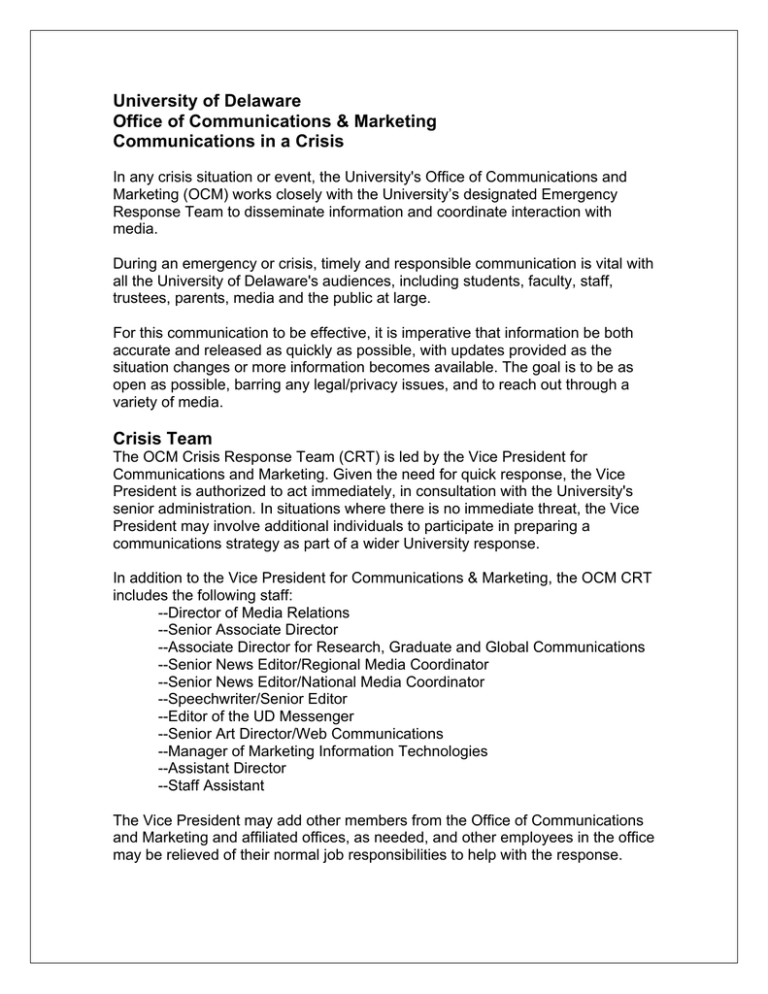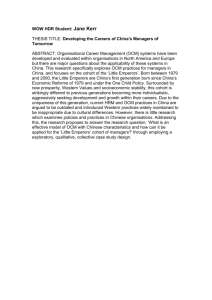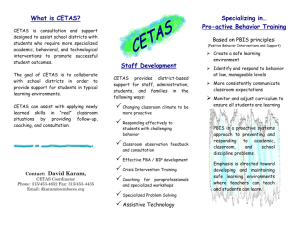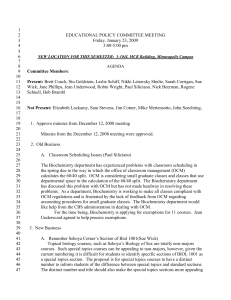University of Delaware Office of Communications & Marketing Communications in a Crisis
advertisement

University of Delaware Office of Communications & Marketing Communications in a Crisis In any crisis situation or event, the University's Office of Communications and Marketing (OCM) works closely with the University’s designated Emergency Response Team to disseminate information and coordinate interaction with media. During an emergency or crisis, timely and responsible communication is vital with all the University of Delaware's audiences, including students, faculty, staff, trustees, parents, media and the public at large. For this communication to be effective, it is imperative that information be both accurate and released as quickly as possible, with updates provided as the situation changes or more information becomes available. The goal is to be as open as possible, barring any legal/privacy issues, and to reach out through a variety of media. Crisis Team The OCM Crisis Response Team (CRT) is led by the Vice President for Communications and Marketing. Given the need for quick response, the Vice President is authorized to act immediately, in consultation with the University's senior administration. In situations where there is no immediate threat, the Vice President may involve additional individuals to participate in preparing a communications strategy as part of a wider University response. In addition to the Vice President for Communications & Marketing, the OCM CRT includes the following staff: --Director of Media Relations --Senior Associate Director --Associate Director for Research, Graduate and Global Communications --Senior News Editor/Regional Media Coordinator --Senior News Editor/National Media Coordinator --Speechwriter/Senior Editor --Editor of the UD Messenger --Senior Art Director/Web Communications --Manager of Marketing Information Technologies --Assistant Director --Staff Assistant The Vice President may add other members from the Office of Communications and Marketing and affiliated offices, as needed, and other employees in the office may be relieved of their normal job responsibilities to help with the response. All members of the OCM CRT will wear University-approved badges or adhere to the applicable University-designated system of identification/credentialing. When an emergency or crisis event occurs, the vice president or his/her designee will contact each OCM CRT member by phone and/or email to convene immediately. In most cases, the Crisis Response Team will initially convene in the OCM Conference Room on the first floor of The Academy Building. In an Emergency Depending on specific circumstances and in coordination with the Emergency Response Team, the OCM CRT will implement some, or all, of the steps below. During the crisis, the team will meet frequently to review changing facts, assess key messages and whether they are effective or need to be changed and to determine additional strategies. Open and frequent communications between OCM's CRT and the Emergency Response Team is crucial. The Vice President for the Office of Communications and Marketing or his/her designee will serve as a member of the University’s Emergency Response Team and act as liaison to the OCM CRT. In an emergency, the goal is to issue the first communication to key University audiences within 30 minutes of notification of the event, followed by regular updates when needed and/or available. Some situations may require even faster initial communications. In an emergency situation involving other agencies or institutions (City of Newark, Delaware Emergency Management Agency, Delaware Division of Public Health, etc.), the OCM CRT will reach out to communication colleagues there to establish a unified and consistent response. OCM's Crisis Response Team will: Designate a secretary – to take meeting notes, compile to-do lists, and maintain information files on the ongoing crisis and other items. Gather, review and record known facts – those that can and cannot be released to the public – to determine if a response is needed and how it should be framed and disseminated to which University audiences. These facts will be used to fill in templates for news releases, text messages, social media and other communication vehicles. As the situation changes, the team will develop new fact sheets that can be used for Web site updates, emails, news releases, social media and other communications. These fact sheets also will help guide the team’s overall strategy as events unfold. Develop several key messages to be included in all University communications. These might include what is being done to ensure student safety and the safety of other members of the campus community or what is being done to ensure that it doesn't happen again. Messages will evolve as circumstances change but should always emphasize the University's core principle of concern and actions to ensure the safety of the members of the University community. Identify subject matter/technical experts as appropriate. For some emergencies such as avian flu, OCM CRT may need to identify faculty/research professionals on campus with expertise in the topic to help develop fact sheets, do media interviews, etc. Designate spokespersons – both a senior administrator of the University and someone charged primarily with communications responsibilities. The senior administrator will serve as the public face of the University, while the communications staff will run briefings and handle media questions between formal press gatherings. One member of the Crisis Response Team will be identified to communicate key messages and emerging facts to the spokespeople and to handle any media training needs. The same information needs to be distributed in a timely manner to senior leaders, including deans and faculty leaders, so they are aware of what is being shared with the public. In an emergency, a high-ranking University senior administrator – in most cases, the president – should serve as the institution's public face and take the lead in communicating key messages and answering questions. Involvement of the top leadership demonstrates that the situation is under control and that efforts are being made to address any additional questions or concerns. As the situation evolves, the senior leader acting as the key spokesperson may change. Get the word out – fact sheets and approved messages will be made available to key members of the University community to share with their constituents. The general philosophy is to first inform the internal audiences that are directly affected, such as students, employees, trustees, and then move to parents, alumni, community members and the media. As a general rule, all information will be available as soon as possible on the University's home page, and all messages should re-iterate that the University's home page is continually updated with any new information that becomes available. The OCM CRT will establish and publicize an email address for campus inquiries that will be monitored throughout the event. If specific communications are needed for particular groups, such as to students in residence halls, the fact sheets and approved messages will be used to shape those specific messages. All University community email communications will be written, reviewed and distributed by the OCM CRT under the authority of the Vice President for the Office of Communications & Marketing or other senior administrator. Senior leadership also may use the fact sheets/messages to communicate with their units (e.g., provost sharing with deans and faculty leaders). Depending on the circumstances, the Crisis Response Team may identify special audiences and assign someone the responsibility of managing communication with the group. For example, one member of the Crisis Response Team will be identified to communicate key messages and emerging facts to the UD Emergency Call Center (located in McDowell Hall). The OCM CRT also will be responsible for contacting media, via email, telephone, etc, to provide updated information. Communicate on the Web. OCM will use the University's home page and UDaily as the primary sources of updated information, linking to special pages or other sites with additional information when appropriate. Social media – Twitter in particular – also will be used as a key means of communications. The interactive nature of social media, including Twitter and Facebook, also provides the opportunity for rumor control. All messages will stress that the most complete, up-to-date information is available on the University's home page. In a major emergency, a stripped-down home page will replace the University's standard home page (see sample in Appendix 2). In addition, in less major emergencies, OCM has the option of using portions of the home page, such as the banner space at the top of the page, for emergency messaging. The web site will include the most current information reportable, as well as a history of external communications pertaining to the crisis throughout the event. The Senior Art Director/Web Communications and the Manager of Marketing Information Technologies, working with the Senior Associate Director, will have the responsibility of managing these changes and keeping the information on the University’s Web site, www.udel.edu, up to date. Assign communicators, as needed, to assist with incoming phone calls, using a script developed with the key messages and facts that the Crisis Response Team has developed. This information also should be shared with other units likely to receive calls during the crisis, such as the general University telephone number, Student Life, the Admissions Office and others. In addition, any prerecorded telephone messages should be reviewed to see if they need to be updated with the emergency information. Key messages will also be sent to the Social Media Steering Committee to ensure information is being pushed out through all available media. As part of this effort, OCM CRT will maintain a log to record all calls and interview requests from members of the media and ensure that all calls are returned. OCM CRT works to be as responsive to the media as possible and to ensure that the University's key messages and facts are shared. Develop communications from the president, as appropriate. It may be necessary for the president to communicate to the University community about the emergency. The Speechwriter/Senior Editor will prepare presidential correspondence and any other written materials, such as talking points, speeches or op-eds when needed. Open the media center, and determine whether press conference(s) should be held. Depending on the situation, OCM CRT will choose a location for the media center based on a number of possibilities identified around the campus. Selection of a site may require assistance from Facilities, IT, Public Safety and Media Services, for establishing telephone lines, Internet connectivity, multboxes, signage, parking, security, etc. If needed, OCM CRT will also establish a schedule for 24-hour staffing for the media center. Communicators from other University offices may be asked to assist with managing the facility and answering media requests. A list of potential media center sites on the Newark campus is listed below. A media center may be established, if necessary, on other UD campuses. Monitor external coverage. An OCM staff member will work with Public Safety in monitoring social media as the situation unfolds. In addition, a member of the OCM team will be responsible for daily monitoring of media coverage, including print, broadcast and blogs. Daily summaries of relevant media coverage will be provided to the University’s senior administration and the Crisis Response Team. A review of how the incident is being portrayed will enable OCM CRT to respond to rumors, incorrect information, etc. Maintain ongoing coverage. The Senior Associate Director will be responsible for coordinating print, video and photographic coverage of responses to the situation that need to be documented and archived on the University's news Web site. Plan for the future. The OCM CRT will evaluate and recommend methods for communicating once the crisis is over. Such methods might include letters from the president, town hall meetings and detailed presentations outlining actions being taken to prevent a reoccurrence of the crisis situation. Assess the response. Within 10 days of the end of the event, the OCM Crisis Response Team will review the crisis and assess the functioning of the plan, address any needed changes or updates and recognize the assistance and contributions of others and complete a written after-action report. Date Prepared: August 13, 2009 Updated: December 19, 2011, February 9, 2012 Newark Campus Media Center Locations In many cases the Office of Communications and Marketing in the Academy Building, 105 East Main St., will serve as the media center. In larger emergencies, those involving other agencies and organizations or where location near the emergency is important, it may be necessary to establish a Media Center at other campus locations. Below is a list of potential locations in different areas of the campus. These have been identified based on parking, Internet access, and computer, phone and electrical service. At the discretion of the Vice President for the Office of Communications and Marketing, and in consultation with the Executive Director of University Public Safety, one or more of these locations may be designated as a media center. Laird Campus Clayton Hall Or Courtyard Newark-University of Delaware South Campus Bob Carpenter Center Or Townsend Hall Central Campus Pearson Hall (Preferred location) Or 200 Academy Street East Campus Career Services Or Human Resources Or Perkins Student Center Northern Central Campus Trabant University Center West Campus Lerner Hall Wyoming Road Delaware Biotechnology Institute





